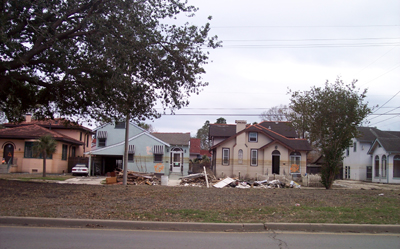
Water marks and fluorescent markings in Lakeview
New Orleans: The City
That America ForgotBy Lance Cutler
Jacques Soulas, co-owner of Café Degas in New Orleans' City
Park area, returned home to 6569 Marshall Foch Street in the Lakeview
district. Silty grey mud covered the streets and the lawn. Trees bent
over at 90-degree angles or lay uprooted on the ground, grasping for
a purchase in the humid air. Jacques stared at the fluorescent orange
"X" on the door to his house, focusing on the "0"
in the quadrant reserved for dead bodies.
Shaken, he approached the house, fit his key into the lock and opened
the door. He first noticed the paintings, his paintings, more than 100
of them. Years of work on oil landscapes of a city no longer there.
The paintings lay in piles, strewn around the studio, each one covered
in mud, canvasses torn and cut, frames split and broken by the churning
floodwater.
Stepping into the living room, he found everything topsy-turvy. He faced piles of water-sodden furniture; a couch bloated like a dead body, a broken dining room table like a sunken raft. Sheetrock dangled from the ceiling, chunks fallen to the floor to stick in the mud. The walls were coated with fuzzy brown pods of mold exploding into kaleidoscopic patterns.
He slipped in the muck as he made his way up the stairs to the bedroom where everything was pristine, untouched, just as he had left it. Disoriented, he sank down heavily on the bed. He plucked a framed family photo from the nightstand, staring at his own smiling face, and his wife Angela, and his two children, Adrian and Sebastian. He frantically collected all the photos in the room. He fumbled through the drawers and gathered together some clothes, but then he had to get out. He was overcome with an urge to get out of the house immediately.
He made his way down the stairs, photos and clothes clasped to his body. He charged through the muddy living room and then froze in front of his paintings. Grasping his things in his left arm, he reached out tentatively with his right, picking through the paintings in the hope of salvaging this one of the Sculpture Garden in City Park or that one of Bayou St. John, but it was futile.
Overwhelmed, unable to think clearly, not knowing what to do or where to begin, Jacques walked to his car. He tossed the clothes and the photos onto the back seat, turned the key in the ignition and drove away. He drove away from the house he had just purchased eight months earlier, the house he bought so his kids could attend the best public school in New Orleans. He left behind the three-bedroom, two-and-a-half bath, split-level home with the beautiful swimming pool, now filled with muddy water and coated with an iridescence that Jacques would have recognized as somewhere between Transparent Red Oxide and Thalo Blue.
Three months after Katrina, the streets are still muddy, as are the lawns, but now hedges of life's flotsam stand at the curb. Piles of mattresses, refrigerators, toilets, sheetrock and insulation rise in long rows three feet high. Broken dolls, twisted bicycles, useless toasters and computer screens extend the rows to four feet wide. Moldy clothes, mildewed drapes and broken blinds cap the unsightly piles.
Jacques' house still stands empty, layered with the yellow-brown lines that marked the receding water. On either side of Jacques' house are empty, darkened houses marked with the same water lines and colored with the Day-Glo orange "X" and its message of death and destruction. Every house on the block, and every house the entire length of the street and every house in the neighborhood bears this silent testament.
In fact, if you start driving east through Lakeview, a pretty much
mid-to-upper class and predominantly white neighborhood, you'll encounter
no one, save for the odd tow truck driver hooking up an abandoned mud-covered
car. You'll see no lights, except for the occasional street lamp casting
eerie shadows on the curbside piles. You'll pass no other moving cars,
except for the rare insurance adjuster or demolition crew chief checking
out a possible job. You'll fly by local favorite restaurants like Tony
Angelo's, La Cuisine and the Steak Knife, all dark and foreboding. All
marked with the telltale lines, the fluorescent "X"s. There
are no open restaurants. No open gas stations. No open bars, clubs,
stores, movie theaters or schools.